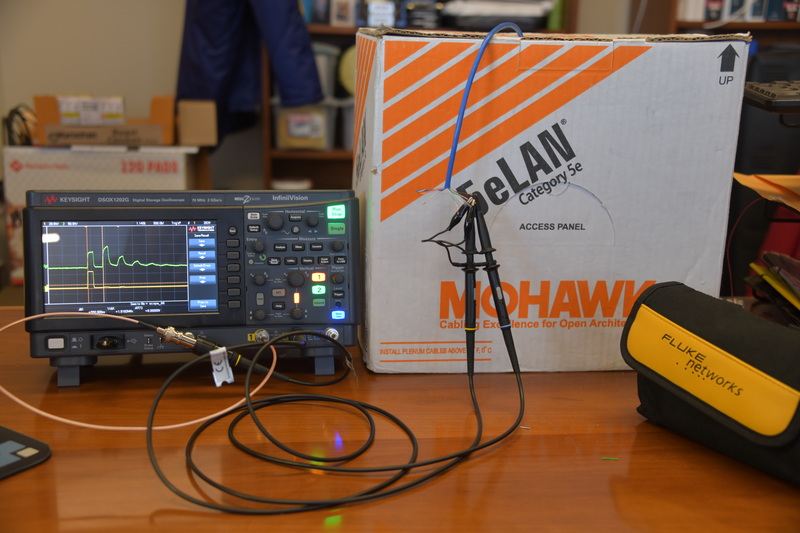
Time Domain Reflectometry is basically radar on a wire. Send a pulse down a wire pair or inside a coax cable and see how long it takes for the echo or bounce. The simple answer is the length of the wire. It can also reveal impedance of the wire but that's a bit more complicated.
Light travels 30 cm per nanosecond (exactly 29.9792458 cm per nanosecond). Because of the inductance and capacitance of wire pairs or coax, a pulse travels slower by the "velocity factor" which for unshielded twisted pair (UTP) is 64 percent (Wikipedia). Anyway, that's 19.2 cm per nanosecond. Since it is a round trip, cut that in half or
9.6 cm per nanosecond or 0.314961 feet per nanosecond (round trip, UTP).
In the example shown here, the round trip pulse time is 550 nanoseconds which works out to 173 feet.
In the screenshot below, a 207 nanosecond pulse is generated 100,000 times per second. There's no magical reason for that particular rate, you could choose one pulse per second and get the same result. The duration of the pulse is chosen to be about half the echo time but it can be almost anything.
The signal generator output and Channel 1 is tied together with a T connector. It isn't really necessary to directly watch the signal generator but why not? Anyway, using a 1X scope probe, apply the pulses to a pair in the 4-pair UTP cable. Using a 10x probe on Channel 2, watch what happens.
The results were a bit mysterious since both channels ought to see exactly the same thing. It turns out that a 1x probe has about 400 ohms resistance, it isn't just a straight wire. So the signal is applied to the cable being tested, through that 400 ohm resistance, and the echo travels back through that same resistance which is why Channel 1 barely sees the echo. Channel 2 sees the echo very strongly, in fact, it has a higher peak voltage than was applied.
If the echo has the same polarity as the pulse, the far end is OPEN. But if the far end is shorted, the echo will have reverse polarity (go negative). If the far end is terminated by a resistance equal to the characteristic impedance of the twisted pair or coax, no echo takes placeation.
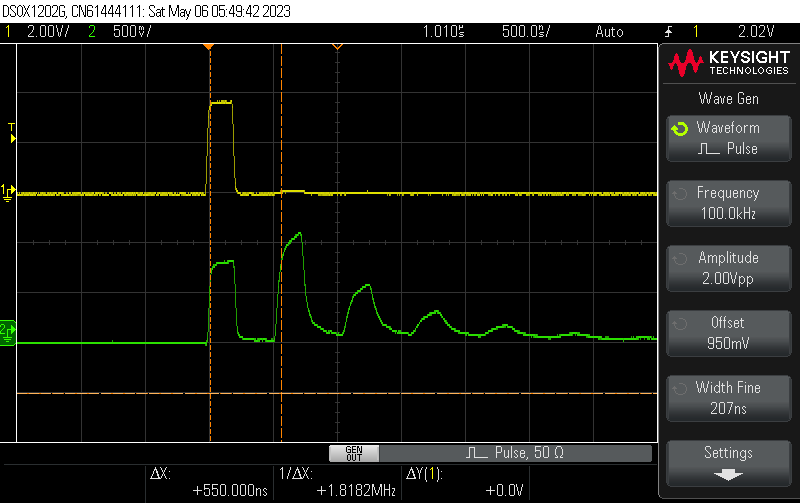
Above: Far end open; echo polarity matches the applied pulse polarity.
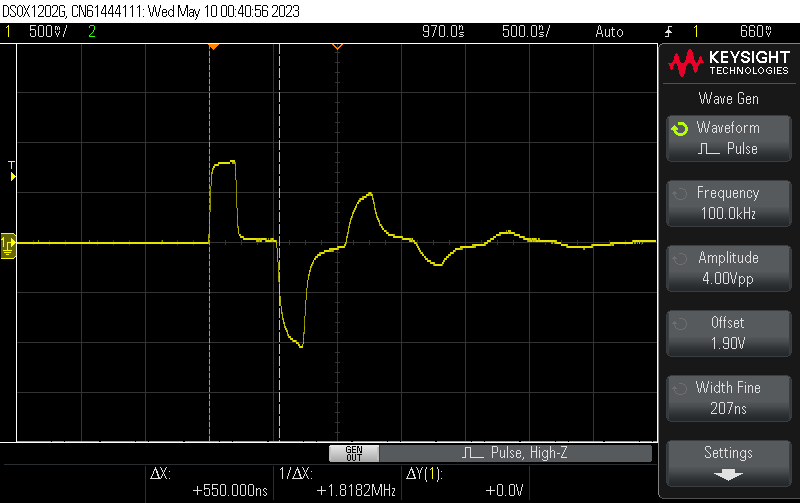
Above: Far end shorted inverts the echo polarity.
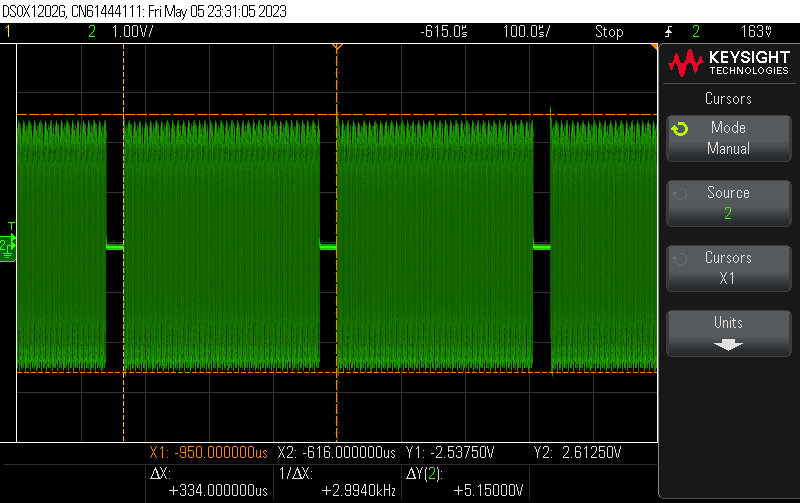
Here, I see a positive going pulse of 128 nanoseconds. The first positive pulse was 468 nanoseconds, the shortest are 75 nanoseconds. It doesn't seem to be any digital line code I am familiar with.
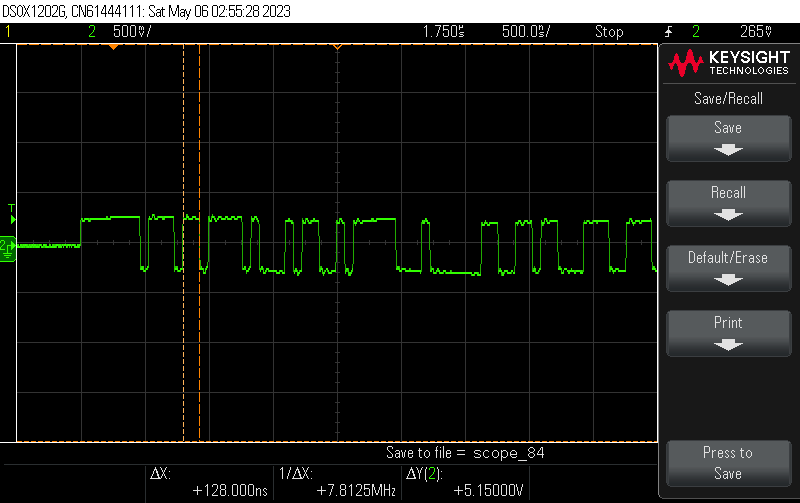
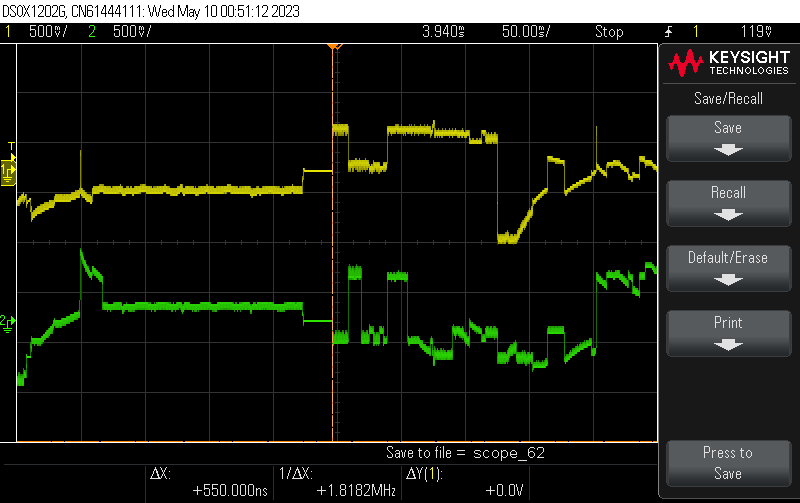
Above: Channel 1 looking at wires 1 and 2; Channel 2 looking at wires 6 and 3. 50 ms per division horizontal. The test is unterminated so no echo is expected or seen. As you can see, it is busy with varying voltages and impulses on different wires at different times.
While performing measurements on the box of ethernet (4 pair cat5e) cable I noticed that channel 2 was bouncing at the same time I was tapping my foot. This was very strange since there is no electrical or mechanical connection of my foot to the oscilloscope or box of wire. That was a week ago and I have performed some experiments to figure out what is happening and for now I'm still not sure what it is.
The test setup probed the solid color and the ground clip on the solid/white color. This pair is twisted around itself and thus eliminate any differential current induction, leaving only "common mode" currents common to both conductors. Induced current on the grounded line will simply go to earth ground, current on the solid color wire will be visible on the scope as a vertical deflection.
Without direct electrical connection I contemplated how this current is being induced. Since there is no closed circuit, magnetism is pretty much ruled out; this is an electric field phenomenon. Electric fields are pretty much everywhere. Some are alternating, as the electric field from a power line, but this one appears to be DC, or static electricity.
Rubbing my feet produced no electricity. Tapping or patting the box of wire produced no effect. Tapping the oscilloscope did nothing. Tapping my foot produces 50 volt spikes and the slope peaks at the moment my shoed foot contacts the floor. Rocking in the chair also produces this phenomenon.
Hypothesis: The steel structures of the building might not be earth grounded, as such it will or could develop a static electric charge from the action of wind on the building and also unbalanced grounds from the three-phase electric power (either or both in combination). As such there's going to be a potential difference between the steel building and Earth ground. Since the oscilloscope is referenced to earth ground it could see this voltage but only if a circuit exists.
A circuit does not exist BUT through the phenomenon of capacitance the oscilloscope can detect changes in the electric field. My body becomes part of the environmental capacitance. Evidently there's a electric field potential (not potential as in "it might happen") difference between the building and earth ground. Tapping my foot brings my body closer to the building potential, which appears to be positively charged relative to earth ground, and my foot approaching this positivity draws electrons down to my foot, which pulls them away from my hand and the scope probe tip which registers a positive voltage. At the moment of peak carpet and shoe compression the rate of change is highest and thus also the voltage seen by the oscilloscope. Interestingly, it appears synchronized with the peak of AC voltage. When I lift my foot, the electrons that had clustered at my foot suddenly return to the rest of my body, including the oscilloscope and a balance is restored.
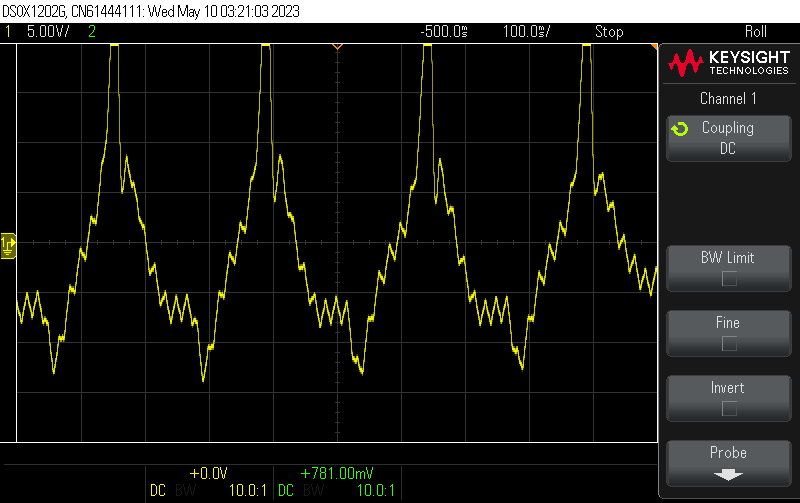
Above: Foot tapping produces a strong impulse. Patting the floor with my hand produces a much smaller impulse but it is still there. Scope setting: 100 ms (millisecnds) per division horizontal, trigger is moved to the left 500 ms, vertical is 5 volts per division. There's about 7 divisions visible but it actually goes up higher about 10 divisions.
Click for movie The first part is foot tapping then leaning forward and back in chair. You can see the trace rise (positive voltage) or sink (negative voltage). The gradual return to zero is because averaging is turned on.